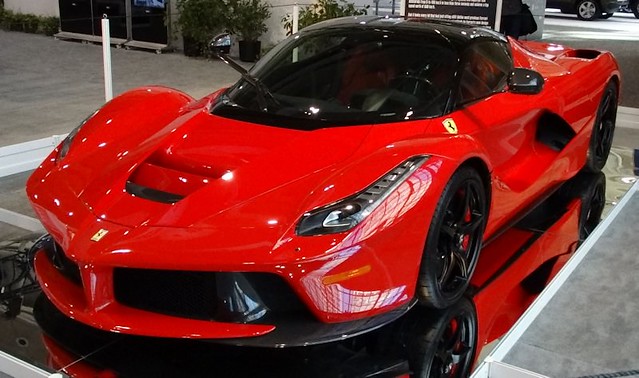 |
| Photo Credit: Chris Nagy |
At the 2013 Geneva Motor Show, the most advanced formation of Italian sports car technology and design of its time was unveiled to the world. Called the LaFerrari, the spiritual successor to the Enzo supercar exhibited active aerodynamics and a hybrid powertrain system called HY-KERS. Besides causing a great deal of confusion on how to properly pronounce the vehicle's name (would we refer to it as Ferrari LaFerrari or just the LaFerrari), the hypercar's factory quoted 949-horsepower generated collectively between a gasoline-fueled 6.3-liter V-12 engine and a pair of electric motors was channeled into the rear wheels for spectacular launches to a top speed up to 217 miles per hour. After the 499 planned LaFerrari models were produced, strong demand paved the way to the open-top version. The 2017 LaFerrari Aperta will be officially unveiled at the Paris Motor Show at the beginning of October.
Every essence of the ultra-performance machine represented a strong, Italian soul. Similar to other Ferrari sports cars but magnified to a climax with the million-dollar LaFerrari, there is a human-like passion and sense of purpose used to merge all components together. The source of this manifestation in each Ferrari is the result of an individual contributions of everyone involved in the creation of a car. Last month, the country of Italy tragically lost what confirmed to almost 300 souls in the aftermath of a damaging earthquake. Besides the ones who perished, the injured and survivors of the August 24th 2016 Central Italy earthquake face an emotional pain from the disaster with some focus being on how-to recover.
Attempting to make some impact in aiding the recovery of the people in their country, Ferrari has authorized the production of a special 500th example of their most special vehicle. Originally capping production of the LaFerrari hardtop at 499 vehicles (which had already been spoken for before prior to construction), the 500th model of the exclusive hypercar was announced during a meeting between the Italian and German government. When built, the 500th LaFerrari will be auctioned off with all proceeds of the sale going to assist in the on-going relief efforts of the earthquake. A rare occasion for purchasing Ferrari's first hybrid production hypercar, the prospect of the vehicle being sold above the original price tag around 1.4-million dollars Canadian in 2014 should almost guarantee a high influx of aid for the Italian victims of the natural tragedy.
The YouTube video below as well as the image used for this article captures one LaFerrari at the 2015 Canadian International AutoShow owned Canadian businessman and Shark Tank personality Robert Herjavec.

Comments
Post a Comment